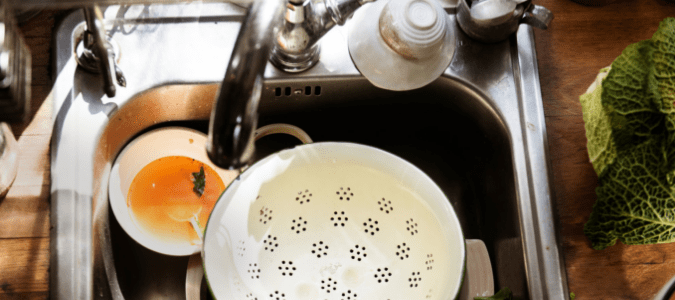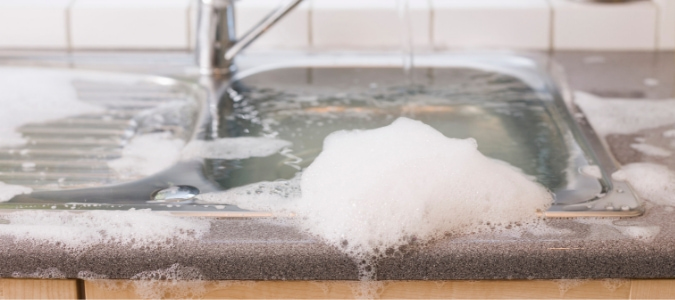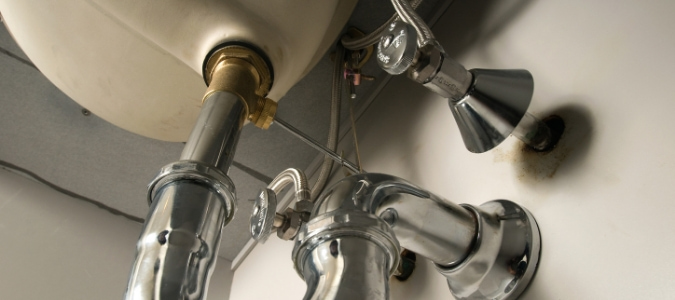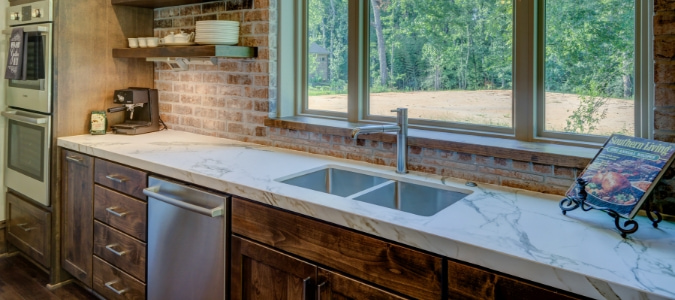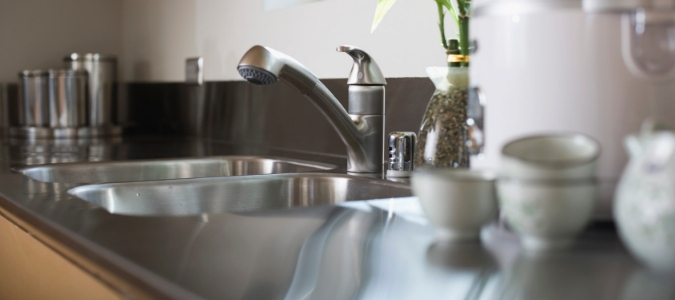
We tend not to think much about our appliances. That is, until something goes wrong.
One evening, as you are going about your normal routine, you scrape your leftover food from your dinner plate, turn on the disposal and wait for that familiar and gratifying noise of food heading down your garbage disposal.
But something’s not quite right. What’s that humming sound? There’s supposed to be roaring. Grinding. Not a soft little purr.
But that’s all you’re getting.
What does it mean? Is there some kind of quick fix? Or is your disposal ruined?
We rely on our garbage disposals after pretty much every meal. We expect these appliances to take whatever we throw at them and keep on going, even when you don’t notice and a spoon slips down your drain or your children put eggshells in the garbage disposal.
Unfortunately, these kinds of common plumbing mistakes—as well as just general wear and tear—can cause garbage disposals to have all kinds of issues.
Keep reading to learn more about how to handle several different common types of disposal problems, starting with that strange humming noise.
How To Fix A Garbage Disposal The Only Hums
So, how do you know if you’re suffering from “humming”?
What typically happens is that a homeowner will turn on the disposal, expecting it to work as usual, and it just doesn’t. The blades don’t turn. The food doesn’t get sucked down. In most cases, instead of the regular whirring noise, the disposal produces a light humming sound.
What’s going on? There are several possibilities.
Jammed Shredding Plates
The disposal could be humming because a shredding plate is stuck or blocked by something it can’t cut through. Like, say, a metal utensil.
What Can You Do?
If you think this might be your problem, try to use a flashlight to check to see if there’s something visibly stuck inside the disposal. If you do notice an obstruction, use a wrench or screwdriver (never your hands!) to try to dislodge whatever’s stuck in there, then remove the item using tongs.
You can also use an Allen wrench (or the disposal’s custom wrench that you probably set aside after your disposal was installed) to dislodge any stuck objects. Do this by inserting the wrench at the bottom of the unit below the sink and wiggling the shredding plate back and forth.
Before you do this, understand that this maneuver that can potentially break your disposal. Most likely it won’t, but the chance is still there, and because of this many people may feel more comfortable leaving this task to a trusted plumber.
Also important to note: sometimes blockages and clogging may occur in parts of the disposal that you can’t see.
Electrical Issues
A humming noise could also indicate some type of electrical malfunction. If your disposal unit overheats, it may trip the circuit breaker, the garbage disposal itself or the GFCI electrical outlet.
These are just a few examples. Many other types of complications involving how your appliance is powered may lead to a humming disposal unit.
What Can You Do?
If you want to troubleshoot an electrical problem, first try resetting the disposal using the disposal reset button. If that doesn’t work, and the disposal isn’t clogged or jammed, your best bet is to call in a plumbing expert to look into the situation further.
End Of Service Life
Sometimes, when a disposal stops shredding and just hums, there’s not much to be done other than to replace it. The unit has simply reached the end of its life span. You can expect a garbage disposal to last between about 8 and 15 years, so if your appliance has been in place as long as you can remember it, it may make sense to replace it rather than attempt a repair.
What Can You Do?
It’s possible to purchase a new disposal yourself, watch some tutorials about removing your old unit and install a new one, all by yourself. However, there are a number of things that can go wrong during both the removal and the installation, so we always recommend enlisting a knowledgeable professional to make sure the job is done right.
What You Need To Know If Garbage Disposal Water Comes Back Up
Another common problem for homeowners is when dirty, grimy water comes back up into the sink when the disposal is turned off, or when water is slow to go down when the grinder is running.
Why might this happen?
As you might imagine, the usual culprit is a clog.
A garbage disposal unit is designed to actively push water through the grinding plates. The water then flows out of the disposal through a pipe into the kitchen’s drain system. Any blockage along the disposal’s drain line may cause water (and any food in your pipes) to back up.
Sometimes, materials from the food debris that the disposal breaks up may get trapped in the unit. Once trapped, the debris builds up progressively until it stops water from flowing through the disposal. This causes the water to flow back up through the disposal’s drain line and into the sink.
Examples of items that may clog a disposal include:
- Eggshells
- Coffee grounds
- Bones
- Fibrous foods (onions and asparagus are two types of these foods)
- Fats, oils and grease
- Certain other “problem” foods, including rice, beans and potato peels
Water may also come back up if the clog is further down in the drain line and not in the disposal itself.
Troubleshooting A Clogged Garbage Disposal
What can you do if you suspect your garbage disposal has a blockage? We suggest you:
- Inspect the disposal unit thoroughly using a flashlight.
- Use a sink auger to snag any clogs and debris in the disposal.
- Use a sink plunger to clear away any debris that might be clogging up the disposal. Be careful when doing this, because plunging with too much pressure might cause damage to the slip joints, resulting in leaks.
- Use a sink cleaner. Sink cleaners are strong cleaning agents that can break up certain clogs and debris.
- Remove and inspect the P-trap (the U-shaped PVC pipe under the sink) for clogs. Remove any materials you find with tongs, pliers or a thorough water flush.
- If these steps don’t work, then it might be that the clog is further down in the drain line. If that’s the case, you’ll need to call in a plumber.
Troubleshooting Garbage Disposal Leaks
You may notice at some point that the area under the kitchen sink is mysteriously soggy. You might also hear an audible drip-drip-drip sound from under there.
What’s going on? Is it your pipes?
You take a further look, and it seems like the answer is no—it’s the disposal itself that’s leaking. Why might this happen?
A Leaky Gasket
If the leak appears on the top rim where the disposal collar (flange) meets the rubber seal, it’s possible that it’s the gasket that’s leaking.
A gasket may develop a leak if:
- It’s old.
- It’s not evenly locked on all sides.
- You go through extended periods of time without using your disposal.
- The disposal has been replaced recently and the rubber gasket doesn’t achieve a water-tight seal.
What Can You Do?
If you have a leaking gasket you should:
- Replace the gasket if it’s old.
- Install the proper gasket if you suspect the gasket is the source of your problem.
- Double check to ensure that gasket is properly and securely locked in place.
A Leaky Flange
The uppermost collar of the disposal is the flange. It’s usually the meeting point for the sink and the disposal. Plumber’s putty should be used to seal the flange, which is an important step to make sure the flange has a proper seal. If the flange isn’t tight enough, the plumber’s putty fails or this component just comes loose for one reason or another, leaks may occur.
What Can You Do?
If you determine that the flange is the reason for your garbage disposal issue, you can:
- Remove the disposal.
- Reseal the flange.
- Re-hang the disposal.
Generally speaking, this is a task for an experienced plumber.
Cracks In The Disposal Body
The lining and outer casing of a garbage disposal may crack with age or due to external pressure and trauma. When the lining is cracked, water may appear at the seams of the disposal.
What Can You Do?
Start shopping for a new disposal.
Unfortunately, a cracked unit can’t be repaired—it must be replaced.
Dishwasher Connection Leaks
If your disposal, like most modern garbage disposal units, is connected to the dishwasher, you might find leaks at the point where the two are connected. The leakage might be due to dishwasher hose cracks or the hose’s clamp not being secure enough.
What Can You Do?
If you notice moisture collecting around the area where the disposal connects to your dishwasher, you can:
- Tighten the dishwasher hose clamp.
- Replace the cracked section of the dishwasher hose.
Leaks Due To Broken Pipes Or Loose Seals
Sadly, it’s all too easy to damage the pipes and seals beneath the sink. When this happens, these pipes can shift, crack or sit improperly. The bolts and seals used to secure those pipes can also fall loose or slip into unusual positions.
What happens then? A leak.
What Can You Do?
We never recommend dealing with leaky pipes and seals on your own. Call in a licensed and experienced plumber to make sure the job is done right the first time and you don’t end up making any costly mistakes.
What If Your Garbage Disposal Smells Like Sewage?
Here’s one scenario that no one wants to deal with. Instead of helping grind up and dispose of food, homeowners notice an unpleasant odor wafting up from the garbage disposal unit. In these cases, a homeowner usually needs the problem fixed, and they need it fixed fast.
Why might this happen? There are two main reasons:
- The disposal was used to grind meals that contained strongly scented ingredients, such as garlic.
- A clog has developed within the disposal unit and the food inside is rotting.
What Can You Do?
If you find yourself in this unfortunate situation, try the following:
- Use the steps outlined earlier to look for and clear any clogs that might be present.
- Clean and scrub the visible parts of the disposal.
- Soak and clean the disposal using soapy water.
- Pour about a dozen ice cubes into the disposal. Add about a half cup of kosher salt. Let a slow stream of water flow, then turn the disposal on and let the appliance process the ice cubes and salt.
- Pour two cups of baking soda and a half cup of vinegar into the disposal. Let these materials sit in your disposal for a full hour. Then, turn on the faucet in a slow stream, along with the disposal. Let the disposal run for one minute.
- Then, flush the disposal with a powerful stream of cold water.
- Cut up lemon peels into 1-inch chunks. Turn the disposal on and let a slow stream of water flow. Feed the lemon peel chunks into the disposal. Peels from other citrus fruits may also be used.
- You can also clean the disposal using bleach and other specialty products that have are designed to get rid of garbage disposal odors.
More Garbage Disposal Tips
What are some other dos and don’ts when it comes to this important small appliance? Keep the following advice in mind:
- Never (seriously, never) try to remove anything from the disposal by putting your hand into it.
- A garbage disposal should never be used as a substitute trash can. Though strong, a disposal isn’t invincible. Be prudent about the items you put into your garbage disposal.
- Flushing the disposal with plenty of water is an excellent way to prevent clogs and blockages. Always keep water running when the disposal is grinding, and continue flushing for 30-60 seconds afterward.
- A great way of cleaning your garbage disposal is grinding up some ice cubes or lemon pieces now and then.
- A cup of baking soda poured into the disposal once a week, followed by a cup of vinegar, will help clear off grease, fats and oils that may cause clogging and odors.
Now for the final, most important tip: don’t bite off more than you can chew where disposals are concerned. Though they may seem like fairly simple, straightforward machines, there are still many things you can do to cause further damage if you don’t know what you’re doing.
ABC Can Resolve Your Garbage Disposal Problems
Speaking of damage, remember that this “simple machine” routinely slices and dices all kinds of incredibly strong materials. Even if you don’t cause more harm to the unit, you could end up seriously injuring yourself. If you’re at all worried that the issue might be beyond you, don’t hesitate to give ABC Home & Commercial Services a call. Our plumbing professionals are fast, efficient and courteous, and they’ll make sure the work is done right from the beginning.
